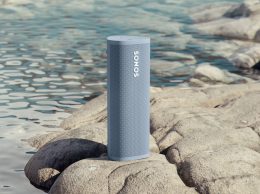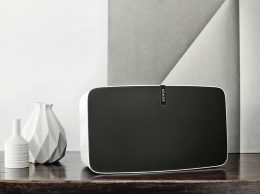Internet of Things lights up CES

David Newton
By David Newton
LAS VEGAS — Another year at the Consumer Electronics Show and more records fell. Attendance topped 173,000 — including 50,000 from outside the U.S. — with 3,800 exhibitors covering 2.5 million square feet.
But this year did not have any truly impressive, jaw-dropping product-tech debuts and felt very much like the last two to three years. The really cool topic remains the advent of the Internet of Things, or IoT, where the Web will move past logging onto a “www” URL to access content and instead free-flow in real-time, seamlessly throughout one’s typical day of interactions at home (web-connected shower, water heater, self-watering flower pots), on the road (connected car, exit signs), at work (thermostats, light bulbs), during lunch (bistro table, interactive menu), shopping (product displays, fitting rooms), dropping the kids at soccer (connected ball, goal-net, shin guards), and picking up some groceries (shopping cart interacts with your fridge’s inventory).
At this year’s CES, IoT was talked about in almost every context of products and services, and dominated the dozen keynote addresses. But is true IoT happening yet? The dozens of supposed IoT products I reviewed lacked imaginative functionality. Prior Internet increments went from competing browsers to data encryption-security (remember 1992, was it safe to enter your credit card online?), to easier and ubiquitous website development, all parallel to ever-faster download speeds, with accessibility across numerous devices — desktops, laptops, then phones, tablets, watches and glasses.
It’s time to get past simply having Bluetooth or WiFi pressed into traditional products for the home and office and instead focus on the meta-functionality, where IoT will deliver useable content instantaneously between people, products and locations — real value added to daily life. Devices will “auto-on/auto-interact” based upon proximity to beacon-initiated wireless signals. That’s why I’m more excited and optimistic about great IoT enablers. Google’s Eddystone (Android and IOS) is going head-to-head with Apple’s iBeacons (IOS only) in the race to deliver IoT to daily life. And OnHub from Asus will facilitate the kind of “physical web” envisioned by Google, where its Nest technologies deliver “learning” thermostats, home cameras and smoke fume detectors.
Sad to say, the IoT at CES was mostly promises of things still to come in the future. The “rollable” display from LG (Val Kilmer’s “towel dispenser” screen in the 2000 film Red Planet) is a pixel technology for still-future interactive-IoT kiosks and street ads. The LeTV Snapdragon phone and Lenovo’s Google Project-Tango phone still look and function very much like every other 5-inch smartphone. IoT wearables remain mostly fitness trackers (Fitbit, AppleWatch) or the new “smart-bra” from OMbra, monitoring heart rate, pulse, and total distance walked/run each day. Sure, I’ve enjoyed MyTracks on my iPhone since 2013 to log my 40,000-plus vertical feet skied on an uncrowded day at Mammoth but it still doesn’t have me “interacting” with conditions and obstacles on Dave’s Run, or wait lines at the base gondola. China’s Huawei had new smart watches trying to mimic Bvlgari elegance, with no real IoT. Dozens of new goggles, head-sets and helmet displays promise future real-time IoT interactions for cyclists, gamers, runners, skiers and boaters — however, the key problem is “future promise.” China’s EHang single-seat drone can transport a person at 60 mph for about half an hour on a single charge (conjures up crazy images of the FAA having to sort these out from thousands of FedEx and UPS delivery drones), but where’s the IoT auto-route mapping?
Great IoT will ultimately deliver seamless “online” embedded in every product and location we interact with each day. Remember Tom Cruise in “Minority Report” going through the retail store that auto-prompted personal messages, sales pitches and special offers tailored to him? That hyper-focused customization to individuals is still developing, however privacy is the major concern of GPS-based locators that ask you to “allow” personal tracking (while also gaining access to everything on your device).
Instead, keep an eye on the IoT emergence of the new Proximal Web being pioneered by firms like my client, GBL Systems in Camarillo, with rich media content auto-interaction to mobile devices based on relative proximity to strategically placed beacons in shops, restaurants, malls, buses, office buildings, city streets — pretty much anywhere. No more URLs, no more hundreds of apps on your device. Just seamless, real-time prompts, instantly viewed, easily shared and with 100 percent privacy and security.
Perhaps the most pressing issue for IoT is how best to capture, process and use the mind-numbing proliferation of big data from these interactions. One person can now generate 300MB of raw data per day (think 1,800 one-page spreadsheets). A person cannot possibly review and utilize such overwhelming numbers and still take care of work, school, family and friends. For now, early IoT looks like incremental change. But we’re getting much closer to the true paradigm shift that will come when IoT innovation renders most URLs and apps obsolete.
• David Newton is a Santa Barbara resident. He is a new venture consultant and teaches strategy at the Center for Executive Development in the Rady School of Management at the University of California, San Diego.











